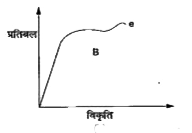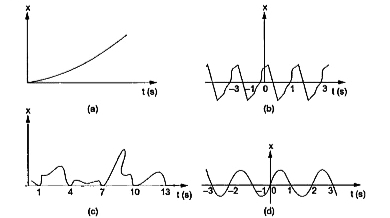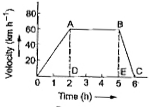सही विकल्प बताएँ
कोई धूमकेतु (come) सूर्य की परिक्रमा अत्यधिक दीर्घवृत्तीय कक्षा (highly elliptical orbit) में करता है। क्या इसकी कक्षा के प्रत्येक निम्नांकित के मान अचर (constant) रहते है ?
(a) रैखिक चाल (linear speed)
(b) कोणीय चाल (angular speed)
(c) कोणीय संवेग (angular momentum)
(d) गतिज ऊर्जा (kinetic energy)
(e) स्थितिज ऊर्जा (potential energy)
(f) कुल ऊर्जा (total energy)
सूर्य की परिक्रमा करनेवाले किसी घुमकेतु की दीर्घवृत्तीय कक्षा के प्रत्येक बिंदु पर केवल उसकी कुल ऊर्जा (गतिज + स्थितिज ) तथा कोणीय संवेग अचर रहते है अन्य सभी राशियाँ परिवर्तनशील होती है
[ (a) एवं (b) ] सूर्य के जितना निकट,रैखिक चाल तथा कोणीय चाल उतनी अधिक (केप्लय के क्षेत्रफल - नियम से )
(c) टॉर्क →τ=→r×→F=→0 अतः कोणीय संवेग →L = अचर
[(d) एवं (e) ] गतिज ऊर्जा एवं स्थितिज ऊर्जा दोनों के मान सूर्य के त्रैज्य दूरी (radial distance) पर निर्भर करते है अतः ये दोनों राशियाँ अचर नहीं रहती है।
(f) दीर्घवृत्तीय कक्षा में गुरुत्वीय बल की दिशा सूर्य एवं धूमकेतु को मिलनेवाली ध्रुवांतर रेखा के अनुदिश होती है और टॉर्क शून्य होने के कारण कुल ऊर्जा अचर रहती है।
Topper's Solved these Questions
- सामान्य भौतिकीBOOK - DAS GUPTACHAPTER - सामान्य भौतिकीEXERCISE - 1.10 प्रत्यास्थता
27 Videos
- सामान्य भौतिकीBOOK - DAS GUPTACHAPTER - सामान्य भौतिकीEXERCISE - 1.11 लघु दोलन : सरल आवर्त गति : लोलक
31 Videos
- सामान्य भौतिकीBOOK - DAS GUPTACHAPTER - सामान्य भौतिकीEXERCISE - 1.8 द्रव्यमान केंद्र : घूर्णन
34 Videos
- सरल रेखा एवं समतल, में कण की गति BOOK - DAS GUPTACHAPTER - सरल रेखा एवं समतल, में कण की गति EXERCISE - प्रश्नावली (आंकिक प्रश्न)
24 Videos
Similar Questions
दो पदार्थो A और B के लिए प्रतिबल - विकृति (stress-strain) ग्राफ चित्र 1.10-1 में दर्शाए गए है। इन ग्राफो को एक ही पैमाना (scale) मानकर खींचा गया है।


किस पदार्थ का यंग प्रत्यास्थता गुणांक अधिक है ?
View Solutionx-अक्ष पर गतिशील कण के लिए चार स्थिति - समय ग्राफ (x-t graph) चित्र 1.11-1 में प्रदर्शित है। कारण स्पष्ट करते हुए बताएँ कि इनमे कौन- कौन से ग्राफ द्वारा आवर्ती गति (periodic motion) व्यक्त होती है तथा उनके आवर्तकाल क्या है ?

View SolutionHCI अणु के दो परमाणुओं (atoms) के नाभिक (nucleus) एक - दूसरे से लगभग 1.27Å की दुरी पर रहते है। इस अणु के द्रव्यमान - केंद्र की स्थिति ज्ञात करे। मान ले कि क्लोरीन का एक परमाणु हाइड्रोजन के परमाणु से 35.5 गुना भारी होता है तथा परमाणु का द्रव्यमान इसके नाभिक पर स्थिर होता है।
View Solutionएक बस का समय-वेग ग्राफ चित्र में दिखाया गया है। निम्नलिखित का मान निकालें-(i) किस समयांतराल में बस की चाल एकसमान है, (ii) किस समयांतराल में बस की गति त्वरित है, (ii) बस कुल कितनी दूरी चलती है, (iv) वह समयांतराल जिसमें बस की गति अवमंदित है तथा अवमंदन का मान क्या है?

View SolutionA comet orbits the Sun in a highly elliptical orbit. Does the comet have a constant (a) linear speed (b) angular speed (c) angular momentum (d) kinetic energy (e) potential energy (f) total energy throughout its orbit? Neglect any mass loss of the comet when it comes very close to the Sun.
View SolutionA comet orbits the sun in a highly elliptical orbit. Does the comet have a constant (a) linear speed (b) angular speed ( c) angular momentum (d) Kinetic energy ( e) potential energy (f) total energy throughout its orbit? Neglect any mass loss of the comet when it comes very close to the sun.
View SolutionA comet orbits the sun in a highly elliptical orbit. Does the comet have constant (a) linear speed (b) angular speed, ( c ) angular momentum, (d) kinetic energy, (e ) potential energy ,(f) total energy throughout its orbit ? Neglect any mass loss of the comet when it comes very close to the sun.
View SolutionA comet orbits the sun in a highly elliptical orbit. Does the comet have a constant (a) linear speed, (b) angular speed, (c) angular momentum, (d) kinetic energy, (e) potential energy, (f) total energy throughout its orbit? Neglect any mass loss of the comet when it comes very close to the Sun.
View SolutionA comet orbits the sun in a highly elliptical orbit. Does the comet have a constant (a) linear speed, (b) angular speed, (c) angular momentum, (d) kinetic energy, (e) potential energy, (f) total energy throughout its orbit? Neglect any mass loss of the comet when it comes very close to the Sun.
View SolutionA comet orbits the sun in a highly elliptical orbit. Does the comet have a constant (a) linear speed, (b) angular speed, (c) angular momentum, (d) kinetic energy, (e) potential energy, (f) total energy throughout its orbit ? Neglect any mass loss of the comet when it comes very close to the Sun.
View SolutionA comet orbits the sun in a highly elliptical orbit. Does the comet have a constant (a) linear speed, (b) angular speed, (c) angular momentum, (d) kinetic energy, (e) potential energy, (f) total energy throughout its orbit? Neglect any mass loss of the comet when it comes very close to the Sun.
View SolutionA comet orbits the sun in a highly elliptical orbit. Does the comet have a constant (a) linear speed, (b) angular speed, (c) angular momentum, (d) kinetic energy, (e) potential energy, (f) total energy throughout its orbit? Neglect any mass loss of the comet when it comes very close to the Sun.
View SolutionA comet orbits the sun in a highly elliptical orbit. Does the comet have a constant (a) linear speed, (b) angular speed, (c) angular momentum, (d) kinetic energy, (e) potential energy, (f) total energy throughout its orbit? Neglect any mass loss of the comet when it comes very close to the Sun.
View SolutionA comet orbits the Sun in a highly elliptical orbit. Does the comet have a constant (a) linear speed (b) angular speed (c) angular momentum (d) kinetic energy (e) potential energy (f) total energy throughout its orbit? Neglect any mass loss of the comet when it comes very close to the Sun.
View SolutionA comet orbits the sun in a highly elliptical orbit. Does the comet have a constant (a) linear speed, (b) angular speed, (c) angular momentum, (d) kinetic energy, (d) potential energy, (f) total energy throughout its orbit ? Neglect any mass loss of the comet when it comes very close to the Sun.
View SolutionIf a boat goes upstream at a speed fo 18 km /hr and comes back the same distance at 30 km/ hr.What is the average speed (in km /hr)for the total journey?
कोई नाव धारा के विपरीत दिशा में 10 किलोमीटर /घंटा की चाल से चलती है और समान दूरी पर 30 किलोमीटर/घंटा की चाल से वापस आती है। कुल यात्रा के लिए औसत चाल किलोमीटर/ घंटा में) क्या है?
View Solution
